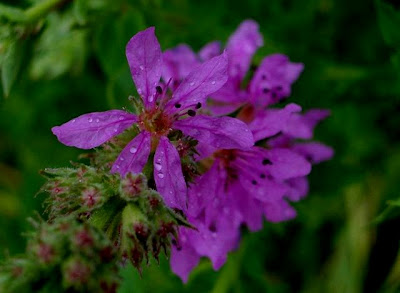
Earth Laughs in Flowers - Emerson
"The stem is 4-angled, very slightly winged between the leaves, stiffly branching and erect. The species name actually refers to the 12 wings at the base of each flower, where the petals and sepals fuse, but neither 'winged' feature is very prominent."
Wisconsin Department of Natural Resources
"Lysimachia is Greek for 'ending strife,' hence our common name loosestrife."
University of Vermont
"The name, 'Loosestrife' comes from the ancient practice of draping these plants over the necks of yoked oxen to 'loosen the strife' between the animals.
East Tennessee Wildflowers
"Its common name of Loosestrife is a very old one, and refers to the belief that the plant would quieten savage beasts, and that in particular it had a special virtue 'in appeasing the strife and unruliness which falleth out among oxen at the plough, if it be put about their yokes.' The plant appears to be obnoxious to gnats and flies, and so, no doubt, placing it under the yoke, relieved the beasts of their tormentors, thus making them quiet and tractable. For the same reason, the dried herb used to be burnt in houses, so that the smoke might drive away gnats and flies. It was particularly valuable in marshy districts. Snakes and serpents were said to disappear immediately the fumes of the burning herb came near them."
Mrs. M. Grieve